Prerequisites (click to view)
graph LR
ALG(["fas:fa-trophy Union Find fas:fa-trophy #160;"])
ASY_ANA(["fas:fa-check Asymptotic Analysis #160;"])
click ASY_ANA "./math-asymptotic-analysis"
SN(["fas:fa-check Set Notation #160;"])
click SN "./math-set-notation"
ASY_ANA-->ALG
SN-->ALG
The Union-Find, aka Disjoint-Set, data structure1 is a deceptively simple algorithm for identifying the disjoint sets in a collection. That is, sets that have no common elements. Stated more rigorously, sets $A$ and $B$ are disjoint if $A \cup B = \emptyset$. It can be difficult to visualize because it’s an inherently abstract concept.
History
The notion of disjoint sets has been in use by mathematicians since the late 1800s. The union-find algorithm was first introduced in 1964 in a paper entitled An Improved Equivalence Algorithm by Bernard A. Galler and Michael J. Fischer2. What’s particularly interesting about this data structure is how it shaped the analysis of algorithms.
At the time of first publication, the practice was not sufficiently evolved enough to accurately specify the algorithm’s asymptotic complexity. In 1973, J. E. Hopcroft and J. D. Ullman published a proof3 that bounded the algorithm at $O(\log^*{n})$4. Robert Tarjan published a stronger proof5 in 1975 that specified an even lower bound of $O(m \alpha(n))$ where $\alpha$ is the inverse Ackerman function6. While it’s true that difference in time bounds is negligible at best, the proofs are excellent examples of algorithmic analysis techniques.
To elucidate, consider popular characters from Romeo and Juliet: Romeo, Juliet, Tybalt, Capulet, Lady Capulet, Montague, Lady Montague, and Benvolio7. For the purposes of this example, a set is defined by family relations. At the beginning of the play, the characters form two distinct disjoint sets as shown below.
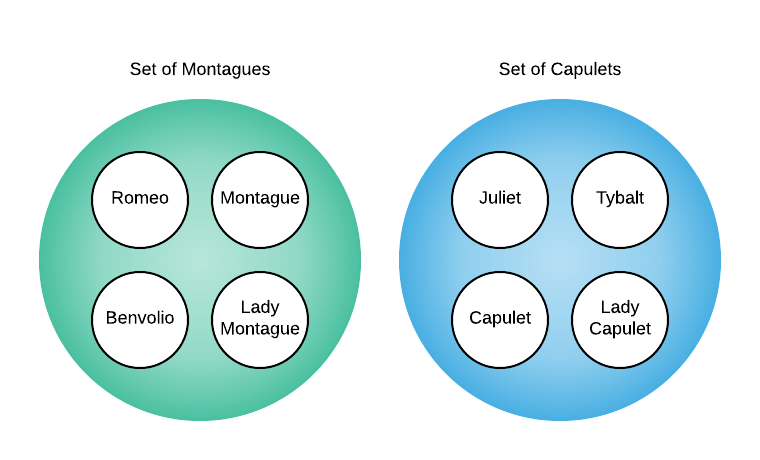
Act 2, scene 5 changes the makeup of the sets when Juliet and Romeo marry. The Montague and Capulet sets are no longer disjoint because they share elements as the image below illustrates.
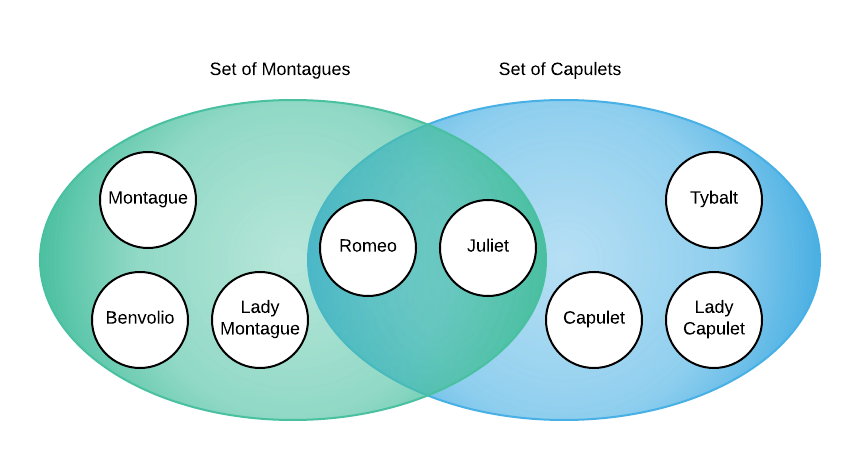
Consider how one might write an algorithm to divine if there are disjoint sets among an evolving set of random objects. Conceptually, the union-find data structure accomplishes this by first defining each object as an independent set and allowing consumers to merge individual items. Merging any two items results in merging their sets. If merging all items results in a single set, there are no disjoint sets. This is shown graphically below.
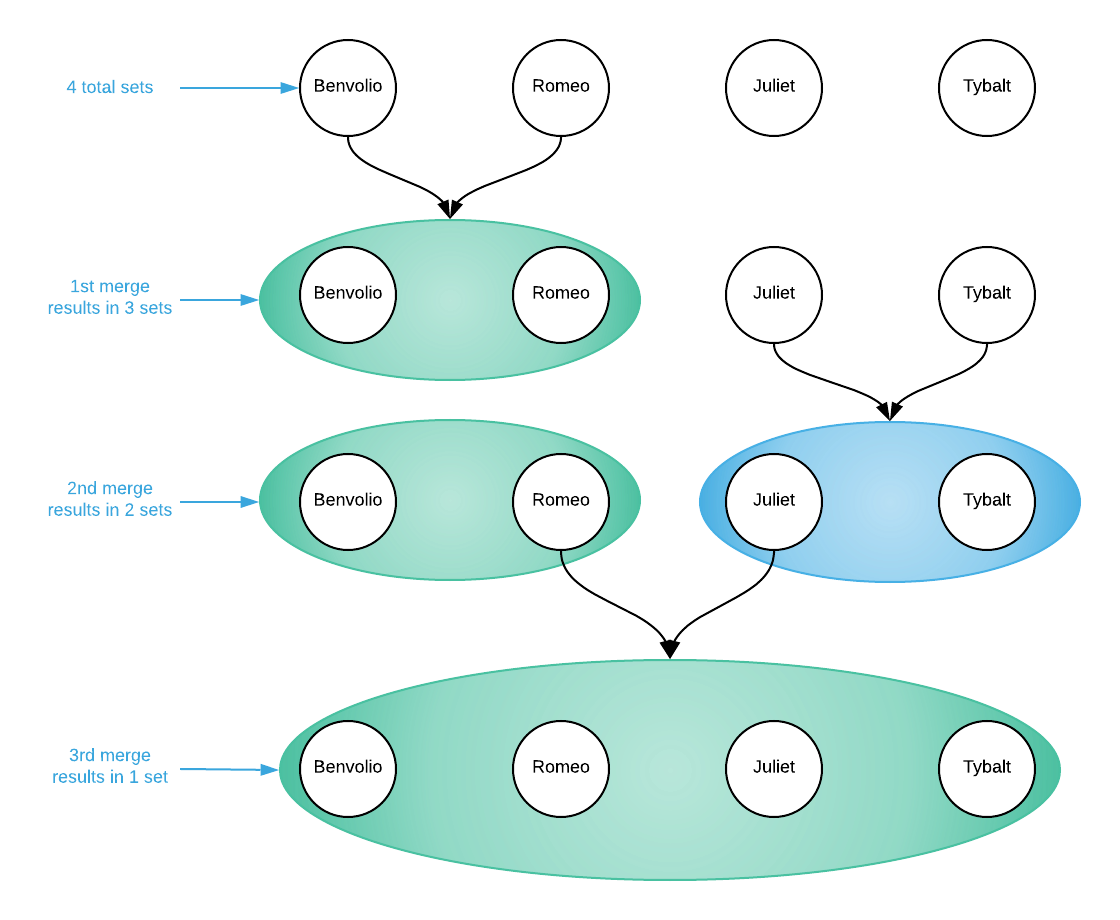
This sub-section outlined the conceptual operation of the union-find data structure, the next describes how this is accomplished.
Union Find Interface
The union-find data structure’s abstract interface defines three operations:
make set, union, and find. make set creates a new set. Sets are tree
data structures. Each set has a set representative that resides at the root of
the tree and each object maintains a pointer to its parent. The representative’s
parent pointer is self-referential. Starting at any object, following parent
pointers will always lead to the set representative. union merges the sets of
two items into one and find returns the set representative for which the
item belongs. This is best demonstrated graphically.
The picture below is a representation of a union-find data structure after 6
make set operations (make set A; make set B; ...). Notice how each object
created a distinct set with a single member that has a self-referential pointer.
At this point, every object is a set representative.

Executing a union operation on A and C deletes set-3 and merges C into
set-1. A is still the set representative but now C’s parent pointer points
to A.
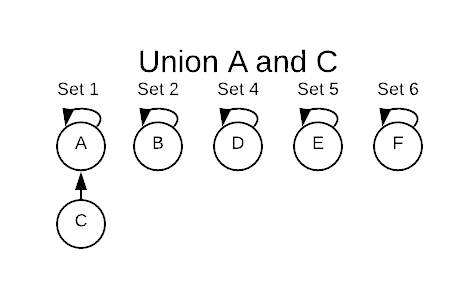
Executing a union operation on A and D deletes set-4 and merges D into
set-1.
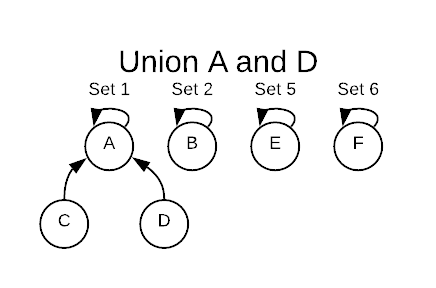
Executing a union operation on E and F deletes set-6 and merges F into
set-5.
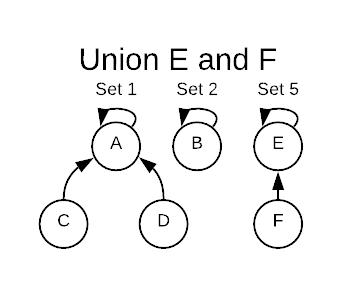
Finally, executing a union operation on E and A merges set-5 into set-1
leaving only two remaining sets.

The find operation returns the set representative for which an object is
contained. Consider the image above. find F will return Set-1’s representative
A. Staring at F, it follows the pointers until it reaches A which has a
self-referential loop. This indicates that it has found its containing set.
Improving Performance
There are two techniques that significantly improve the performance of union-find data structures: union by rank and path compression.
Union by rank ensures that when two sets are merged, each leaf of the tree will
have the shortest possible path to the root. Shorter paths mean fewer traversals
for each find operation. Consult the image below. There are two possibilities
for merging set-1 and set-2. If set-2 is consumed by set-1, it results in more
work for the find operation.
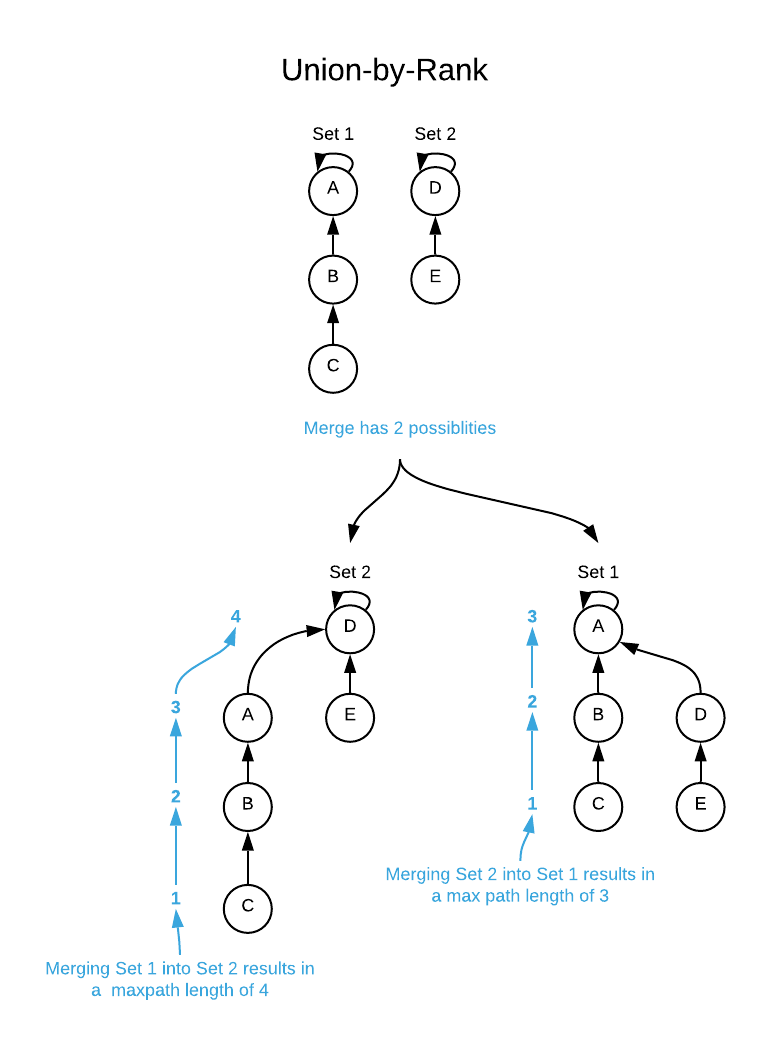
The general idea is to maintain a rank value for each set. Lower ranks are always consumed into sets with higher ranks. See the pseudo code for more details.
Path compression takes advantage of the find operation. Each find operation
requires a path traversal to the root. It takes no extra time to update each
node to point directly to the root thereby compressing the path. This is
depicted graphically below.
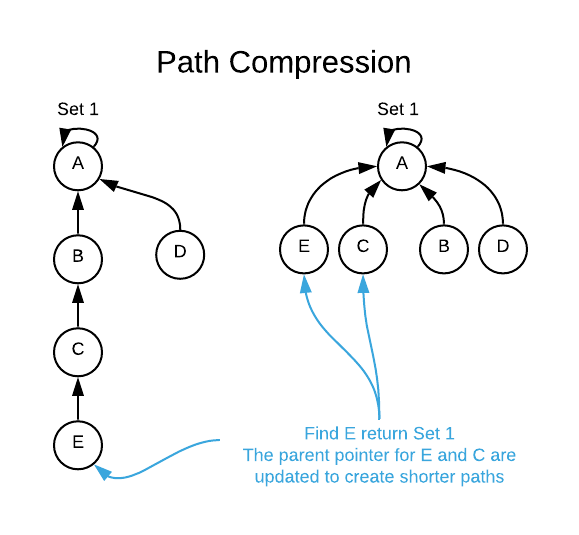
In conclusion, the union-find data structure is deceptively simple yet is sometimes difficult to comprehend due to its abstract nature. It’s purpose is to identify disjoint sets within a collection of loosely connected objects.
Applications
- Kruskal’s Minimum Spanning Tree
- Detecting cycles in a graph
Asymptotic Complexity
- Make Set: $\Theta(1)$
- Union: $O(n), \Omega(1)$
- Find: $O(n), \Omega(1)$
The bullet points above, though accurate in the most technical sense, are
deceiving. While it’s true that a single union or find operation may take
$O(n)$, it’s actually closer to $\Theta(1)$. Remember that each find operation
reduces the run time to $\Theta(1)$ for all future find operations for all
nodes in the path.
Assume that $n$ is the number of make set operations and $m$ is the total
number of make set, union, and find operations combined8. The
amortized asymptotic complexity works out to $O(m \alpha(n))$ Where $\alpha$ is
the inverse Ackerman function. The particulars of the function are not
important. The salient concept is that the function grows very slowly. It will
not exceed $4$ for values of $n$ as high as $10^{600}$. For all practical
intents and purposes, one can assume all operations are constant ($\Theta(1)$).
Pseudo Code
\begin{algorithm}
\caption{Union Find Data Structure}
\begin{algorithmic}
\REQUIRE obj = obj that will act as a set representative
\ENSURE obj becomes a set representative
\FUNCTION{makeset}{obj}
\STATE obj.parent $\gets$ obj
\STATE obj.rank $\gets$ 0
\ENDFUNCTION
\STATE
\REQUIRE obj = obj to find representative for
\OUTPUT obj that is the representative obj's set
\FUNCTION{find}{obj}
\IF{obj.parent != obj}
\STATE obj.parent $\gets$ \CALL{find}{obj} \COMMENT{path compression}
\ENDIF
\RETURN{obj.parent}
\ENDFUNCTION
\STATE
\REQUIRE x = an initialized with the makeset method
\REQUIRE y = an initialized with the makeset method
\ENSURE the sets represented by x and y are merged into a single set
\FUNCTION{union}{x, y}
\STATE set1 $\gets$ \CALL{find}{x}
\STATE set2 $\gets$ \CALL{find}{y}
\IF{set1 = set2}
\RETURN{}
\ENDIF
\STATE
\IF{set1.rank $\gt$ set2.rank} \COMMENT{union by rank}
\STATE set2.parent $\gets$ set1
\ELSE
\STATE set1.parent $\gets$ set2
\IF{set1.rank = set2.rank}
\STATE set2.rank $\gets$ set2.rank + 1
\ENDIF
\ENDIF
\ENDFUNCTION
\end{algorithmic}
\end{algorithm}
Implementation Details
For the sake of brevity, this pseudo code makes two assumptions: the first is that it does not need to maintain the total number of sets and the second is that it can freely modify objects (see lines 3 and 4). This will NOT be the case for general-purpose union-find data structures.
A common implementation technique is to maintain a hash table of sets using the objects themselves as keys. The code below is a simplified representation of the approach.
// error handling is omitted for brevity void make_set(DisjointSet* self, void* obj) { Set* new_set = malloc(sizeof(Set)); new_set.rank = 0; new_set.parent = new_set; // self.sets is a hash table, obj is the key value, and new_set is the stored object HashTable_Put(self.sets, obj, new_set); } void find(DisjointSet* self, void* obj) { // self.sets is a hash table, obj is the key value Set* set = HashTable_Get(self.sets, obj); if (set.parent != set) return find(set.parent); return set.parent; }
Source Code
Relevant Files:
Click here for build and run instructions
Exercises
-
Assuming you have invoked $n$
make setoperations on a union-find data structure:
a. What is the maximum number ofunionoperations that can be invoked on items contained in disjoint sets?
b. Does the answer to questionachange depending on the order in which constituent items are merged?Answers (click to expand)
- $n-1$ - Every successful union operation results in reducing the total number of sets by 1.
- No, items can be merged in any order and achieve the same results.
-
Assume you have an empty union-find data structure, define the resulting sets given the following sequence of operations:
a.make_set(A), make_set(B), make_set(C), union(A,C), union(B,C)
b.make_set(A), make_set(B), make_set(C), make_set(D), union(A,D), union(B,C), union(C,D)
c.make_set(A), make_set(B), make_set(C), union(A,B), make_set(D), union(B,C), union(A,C)Answers (click to expand)
a.
make_set(A) = {A} make_set(B) = {A}, {B} make_set(C) = {A}, {B}, {C} union(A,C) = {A, C}, {B} union(B,C) = {A, C, B}b.
make_set(A) = {A} make_set(B) = {A}, {B} make_set(C) = {A}, {B}, {C} make_set(D) = {A}, {B}, {C}, {D} union(A,D) = {A, D}, {B}, {C} union(B,C) = {A, D}, {B, C} union(C,D) = {A, D, B, C}c.
make_set(A) = {A} make_set(B) = {A}, {B} make_set(C) = {A}, {B}, {C} union(A,B) = {A, B}, {C} make_set(D) = {A, B}, {C}, {D} union(B,C) = {A, B, C}, {D} union(A,C) = {A, B, C}, {D} // no change, the two sets are already merged -
The romeo_juliet_graph.txt text files describes the relationships of Romeo and Juliet characters. Each line represents such a relation in the following format:
{Character}<tab>{Relationship}<tab>{Character}
Possible relationships includeknowsandkin. Using the programming language of your choice, write a program that:- parses the file
- creates a set in a union-find data structure for each distinct character
- unions each set of characters that have a
kinrelationship - displays the resulting sets
Answers (click to expand)
See the C implementation provided in the link below. Your implementation may vary significantly and still be correct.
disjoint_set_test_case.c
The final output should resemble:total number of sets = 9 Set Representative = Friar Laurence, Members = Friar Laurence Set Representative = Benvolio, Members = Benvolio Set Representative = Apothecary, Members = Apothecary Set Representative = Friar John, Members = Friar John Set Representative = Mercuito, Members = Mercuito Set Representative = Nurse, Members = Nurse Set Representative = Romeo, Members = Lord Montague, Romeo, Lady Montague Set Representative = Prince, Members = Prince, Paris Set Representative = Juliet, Members = Juliet, Tybalt, Lady Capulet, Lord Capulet
-
It’s not uncommon to encounter union-find described as an algorithm and disjoint-set as the underlying data structure used by the algorithm. In the author’s opinion, the term “disjoint set data structure” is confusing because disjoint sets are what the algorithm is attempting to identify. Alas, we are actors participating in a history we didn’t create yet are nonetheless compelled to perpetuate. ↩
-
Available online at https://dl.acm.org/doi/10.1145/364099.364331 ↩
-
Available online at https://epubs.siam.org/doi/10.1137/0202024 ↩
-
$\log^*$ is an iterated logarithm. Although the concept isn’t particularly germane to the matter at hand, curious reader can find out more here: https://en.wikipedia.org/wiki/Iterated_logarithm ↩
-
Available online at https://dl.acm.org/doi/10.1145/62.2160 ↩
-
It’s sufficient to understand that the inverse Ackermann function grows unbelievably slowly; it will not exceed $4$ for values of $n$ as high as $10^{600}$. Curious readers can find more information here: http://www.gabrielnivasch.org/fun/inverse-ackermann ↩
-
It’s unfortunate that my favorite character, Mercutio, didn’t fit into this example. He is neither Capulet or Montague; therefore, he makes up his own disjoint set. ↩
-
The maximum number of
unionoperations that can be executed on any union-find data structure is $n-1$. At that point, there is only a single data set left. ↩